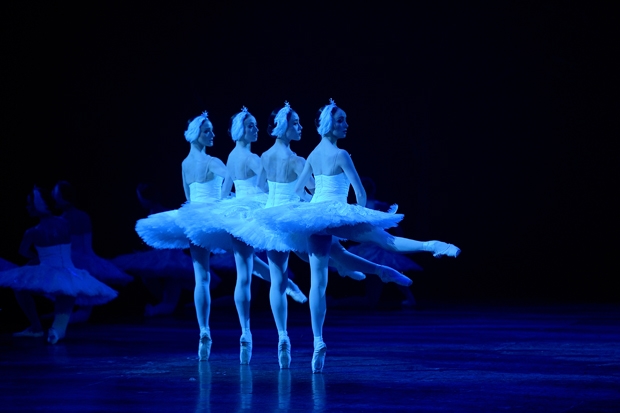Was Tamara Rojo, when she danced Swan Lake last Saturday at the Albert Hall, thinking as she shaped each phrase, ‘This will be the last time I dance this …and this …and this’? I wonder. She told me a few years back that she had a five-year diary to cover the rest of her dancing career, a diary ending in 2016. Akram Khan’s modern Giselle this autumn will be a Rojo role, but if at 42 she was privately saying farewell to her classical career on Saturday, she did it with the spectacular and refined artistry the public has come to expect.
A woman sitting next to me complained that the 5ft 2in Rojo is too short for this ballet. To which I responded that Rojo understands the possibilities for romantic connection with her princes and for wickedness in her manipulations of a good man as few other ballerinas ever have. The sad poetry of this fantastic artwork of theatre is not about long legs.
Nor is it about the notorious 32 fouettés — though Rojo is still the queen of those devilish whipping turns of Act 3. Count them if you must, but you must also discuss her immaculate timing of the role’s stunts, the controlling of her foot on the music to pick out, like a conductor’s baton, a tiny syncopation of Tchaikovsky’s, the dynamic arc and cadence that she gives to each group of spins.
Unfortunately, Derek Deane’s in-the-round version of Swan Lake for English National Ballet — which he actually made for Rojo herself 20 years ago (and I recall my amazed sense that night that someone great had arrived in the art form) — is a grandiose, mechanical swan tattoo, rather than a piece of poetry.
Deane didn’t traduce the text as such, he simply killed it. He faithfully took most of the text of the fine Royal Ballet productions he grew up with as a dancer and multiplied it all four ways, upped the numbers (60 swans a-swimming!), so 4,000 spectators get their view from all sides. Pas de trois becomes pas de douze, the four cygnets are eight, it’s only a surprise that there aren’t four Odettes too.
It’s nice for ENB that most of the public always yell with enthusiasm at it, that they are not distressed as I am by precision-drilled lines of five dozen clattering swans (which always makes me think of Khrushchev’s grotesque chat-up line to Plisetskaya, that at night he dreamed of swan girls and tanks mixed up together). The heartbreaking drifts of swans you have in proper stage productions are here reduced to gridlines. The music from the orchestra, perched far away and overhead, is a tinny little blare in an echo chamber.
These are trying circumstances in which to bid goodbye to one of the two greatest Odette/Odiles of my experience. The other is the 5ft 9in Uliana Lopatkina of the Mariinsky, whose fatalistic spirituality is worlds away from little Rojo’s womanly, psychologically varied interpretations, but both ballerinas are utterly absorbed in the music and the technical self-perfecting that enables them to tell us their different versions.
Rojo picked a damn good-looking partner, Isaac Hernández, from Mexico, who has a rare naturalness in his grace and polish but a not very committed dramatic presence. But finally, in the ‘Black Swan’ coda of Act 3, responding to Rojo’s provocative feats of virtuosity, he acted as if electrocuted and leapt around the arena in circles of wonderfully high, beautifully free jetés. Someone wolfwhistled him, the rest of us just roared.
I am not sure the luminous Alina Cojocaru, the first-night cast, would have been thanking her boss for her own partner, the Cuban Osiel Gouneo, another new Rojo hire, who by comparison with Hernández is all competition bling. In future, Rojo’s directorship will come under even more microscopic scrutiny than her dancing, and she needs to ensure that her flashy young chaps learn some courtly manners and some seriousness of mind. The lake of swans is a place of desolation, not a tourist spot.
Jonathon Young’s desolation can hardly be imagined. The Canadian theatre director and his family were on holiday in 2009 when the cabin where his young daughter, niece and nephew were sleeping burned down, killing all three. Young sank into a pit of drug-addicted grief, plagued by memories of trying to save the children from the fire. How is it possible that this could be turned into theatre that isn’t just squirmingly bad-taste therapy?
It’s possible through remarkable artistry. The empathetic ingenuity of choreographer Crystal Pite in creating a garish song-and-dance troupe around him, as both his tormenting thoughts and his saviours, made Betroffenheit at Sadler’s Wells a profoundly moving exploration of shattering pain and the instinct to recover. Inside a coldly lit hospital cell, Pite grouped the six performers with fantastical imagination: with kindness, with scary cruelty, in nightmare costumes, or as friends. Words failing the experience Young was going through, they danced about it.
You can hardly ask for such a show to be given anything longer than a two-night run. Those of us who saw it won’t forget it.






Comments